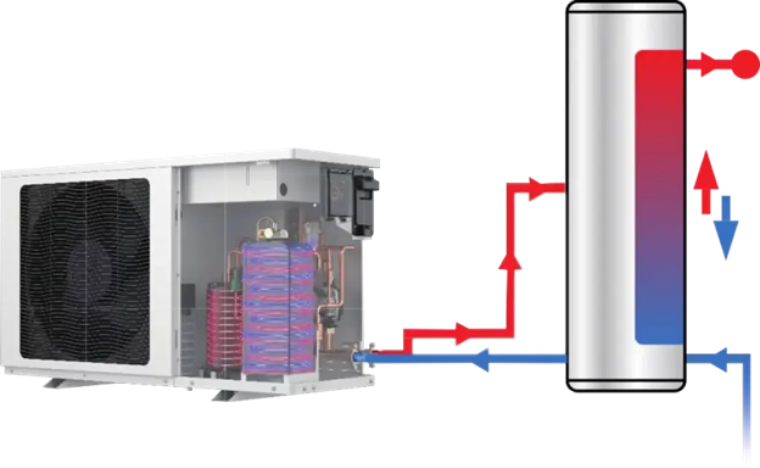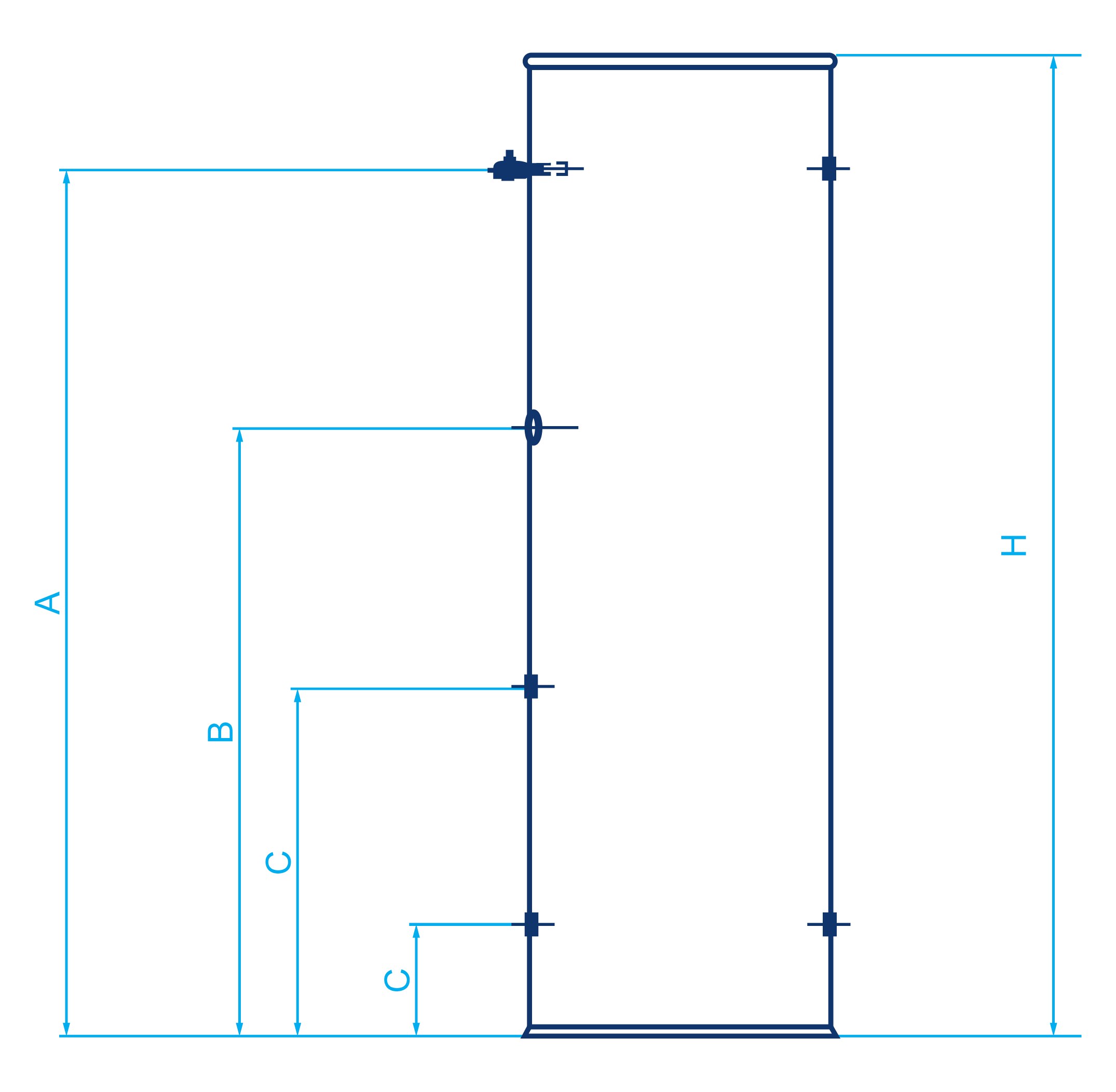The Ultimate Guide to Heat Pump Hot Water Systems: How They Work, Their Longevity, and Energy Efficiency
Tired of sky-high energy bills? Looking for a more eco-friendly hot water service? Wondering if heat pump hot water systems are worth it? We’re to answer all of your burning questions.
In a recent Canstar Blue study, it was found that hot water accounts for approximately 25% of the average household power bill (Source: ABC Australia). These figures underscore just how important hot water efficiency can be.
Heat pump hot water systems represent one of the most significant advancements in residential water heating technology. Unlike traditional electric or gas water heaters, heat pumps harness renewable energy from the surrounding air, with some systems found to be up to 78% more efficient.
Throughout this comprehensive guide, we’ll cover everything you need to know about heat pump hot water systems—from how they work to installation requirements and cost analysis.
Understanding Heat Pumps
Heat pumps operate much like your refrigerator—but in reverse. Rather than removing heat from an enclosed space, they extract warmth from the surrounding air and transfer it to water.
Essentially, a heat pump is a device that moves heat from one place to another using a small amount of energy. This represents a stark contrast to gas based systems that burn fuel to generate heat.
In this case, it uses electricity to capture heat that already exists in the environment. This process makes heat pumps incredibly efficient compared to conventional heating systems. Even in cooler temperatures, there’s still ambient heat in the air for these systems to harness.
Heat pump technology represents a significant shift from traditional water heating methods, particularly in regards to sustainability and energy consumption.
Think of a heat pump as a refrigerator working in reverse—instead of removing heat from food, it extracts heat from the air and transfers it to your water!
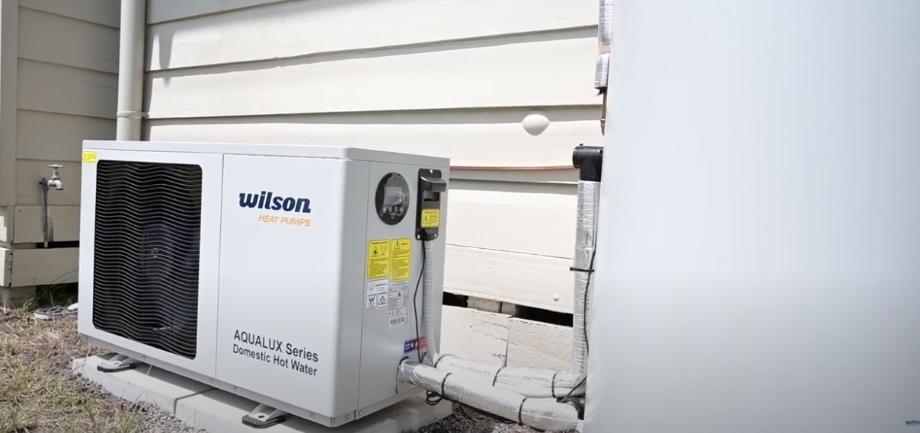
What Is a Heat Pump?
A heat pump is a mechanical system that transfers thermal energy from a cooler space to a warmer environment. Once operational, the pump uses a refrigeration cycle to reverse this natural flow, extracting heat from the air, ground, or water and concentrating it for useful purposes (such as heating water).
The technology behind heat pumps isn’t new. What’s really changed, however, is the overall efficiency and reliability of these systems. More advanced heat pumps, such as the Wilson Aqualux series, are highly effective even when outdoor temperatures drop well below freezing (as low as -25°C).
In the context of hot water systems, heat pump technology has become an energy-efficient alternative to traditional water heaters. Because they tap into the renewable heat sources all around us, these systems have become a great way to reduce both energy consumption and greenhouse gas emissions.
Key Components and How They Operate
A heat pump hot water system consists of several key components working together to efficiently heat water. There are two main types of systems:
-
Integrated systems:
The heat pump unit (which contains the evaporator, compressor, and heat exchanger) is mounted directly on top of or beside the storage tank. -
Split systems:
The heat pump unit is separate from the storage cylinder, with refrigerant pipes connecting the two.
How these Components Work
-
Evaporator:
The Absorbs heat from the surrounding air, transferring it to the refrigerant. -
Refrigerant:
A special fluid with a low boiling point that absorbs heat and circulates through the system. -
Compressor:
Pressurises the refrigerant, raising its temperature significantly. -
Heat exchanger (condenser):
Transfers heat from the refrigerant to the water inside the storage tank. -
Expansion valve:
Reduces the pressure of the refrigerant, cooling it before it returns to the evaporator. -
Storage cylinder:
Holds the heated water until needed, usually insulated to maintain temperature. -
Control system:
Regulates the process, ensuring optimal efficiency and temperature control.
The process works like this: The evaporator pulls heat from the air while the refrigerant absorbs this heat and turns from liquid to gas. The compressor then pressurises this gas, raising its temperature significantly—much like how a bicycle pump gets warm when you inflate a tire.
The hot, pressurised refrigerant passes through the heat exchanger wrapped around the water tank. Here, the heat transfers to the water while the refrigerant cools and returns to liquid form. Finally, the expansion valve reduces the refrigerant’s pressure, cooling it further before it returns to the evaporator to begin the cycle again.
Heat Pumps vs. Traditional Hot Water Units: Why Are Hot Water Heat Pumps Energy Efficient?
When we compare heat pumps to more conventional electric water heaters, the difference is stark. Why? Traditional electric systems use heating elements (essentially large resistors) to convert electricity directly into heat. This is inherently inefficient, with a coefficient of performance (COP) of just 1.0, meaning one unit of electricity produces one unit of heat.
Heat pumps, on the other hand, typically achieve COPs between 3.0 and 5.0. Leading models (including the Wilson Aqualux models can achieve an impressive COP of 4.52 under standard conditions, meaning they produce over four units of heat using just one unit of electricity—the rest comes free from the environment. This translates to energy savings of up to 78% compared to conventional electric systems.
With a COP of 4.52, you're essentially getting 78% of your hot water energy for free from the air around you! Few home upgrades offer this level of ongoing efficiency.
Gas systems fare somewhat better than electric resistance heaters in terms of running costs but still can’t match the efficiency of heat pumps. Plus, they produce carbon emissions directly during operation.
Heat pumps also offer significant advantages from an environmental standpoint. Even when powered by grid electricity, their exceptional efficiency naturally translates to lower overall emissions, even more so when paired with solar panels.
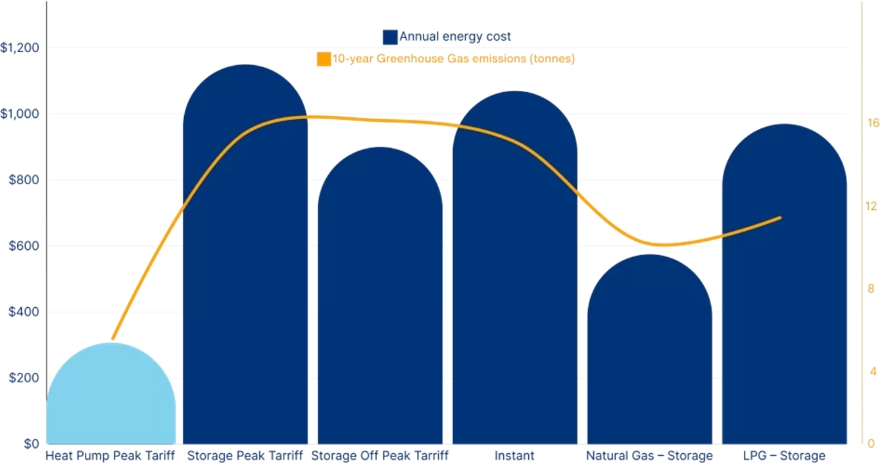
How does this all look in real terms? Referring to the graph from Sustainability Victoria to illustrate why hot water heat pumps are so energy efficient . As you can see, both the ongoing costs and greenhouse gas emissions are significantly lower when a heat pump system is operating. These figures were based on an average 4 person household in Victoria.
These calculations should be used as a guide only. Your water heating energy costs will depend on:
- The amount of people in the household
- How hot water is used
- Energy tariffs
- The climate
- System efficiency
- Length and insulation of connecting pipes
- Flow rates (water efficiency) of taps and showers.
- Traditional electric water heaters: COP of 1.0
- Gas water heaters: Varies, but less efficient than heat pumps
- Heat pump water heaters: COP of 3.0-5.0 (premium models like Wilson Aqualux reach 4.52)
- Potential energy savings: Up to 78% compared to conventional electric systems
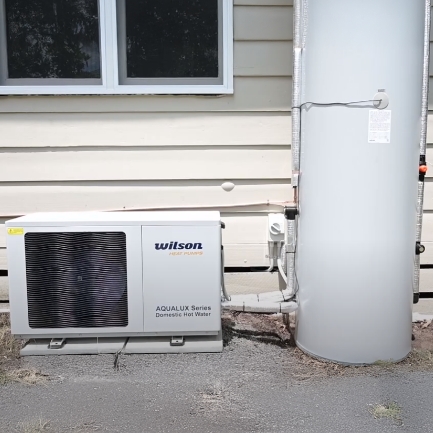
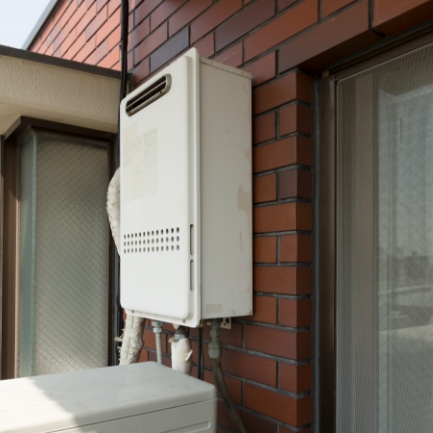
How Does a Heat Pump Hot Water System Work?
At its core, a heat pump hot water system works by extracting ambient heat from the surrounding air and transferring it to your water supply. This process is far more energy-efficient than generating heat directly through electrical resistance or combustion.
The Science Behind Heat Transfer
The process ultimately relies on the basic principles of thermodynamics.The refrigerant within the system has a very low boiling point, and this is what allows it to absorb heat energy and transition from liquid to gas.
As this gas is compressed, its temperature rises significantly—following a similar principle that when a gas is compressed, the temperature increases. This highly efficient process is what allows heat pumps to achieve their remarkable energy efficiency ratios.
What Is a Heat Pump Hot Water System?
A heat pump hot water system combines heat transfer technology with a water storage tank. Unlike instant water heaters that generate heat on demand, heat pump systems work continuously at a steady, efficient pace to maintain a tank of hot water that’s ready for use.
The Wilson heat pump models come with a split system design that separates the heat pump unit from the storage tank. This provides greater installation flexibility and allows the tank to be located indoors, while the heat pump unit remains outside where it can access abundant air flow.
A New Generation of Heat Pump Systems
The technology behind heat pump hot water systems has evolved significantly in recent years. These advancements have dramatically improved efficiency, reliability, and user experience. Let’s take a look:
Cutting-Edge Components
Inverter Compressor Technology
Unlike fixed-speed compressors that constantly turn on and off, inverter compressors (such as the Mitsubishi inverter compressors used in the Wilson Aqualux system) have the capacity to vary their operational speed to match demand. This results in:
- Lower energy consumption
- Reduced wear on components
- Significantly quieter operation
- More consistent water temperature
Variable Speed Fan Motors
DC fan motors that operate at variable speeds offer an array of different benefits, including:
- Minimised noise and vibration
- Optimised airflow for maximum heat extraction
- Lower energy consumption while maximising hot water production
Electronic Expansion Valves
These components allow for precise control over refrigerant flow, working in conjunction with the system’s microprocessor to:
- Maximise hot water production efficiency
- Minimise energy consumption
- Deliver consistently high Coefficient of Performance
Double-Layer Stainless Heat Exchangers
Advanced heat exchanger designs provide:
- Maximum protection from refrigerant entering the water system
- High-efficiency heat transfer to water
- Superior durability and longevity
Automated Safety Systems
Finally, features like built-in air exhaust valves allow for continuous operation even if air enters the system.
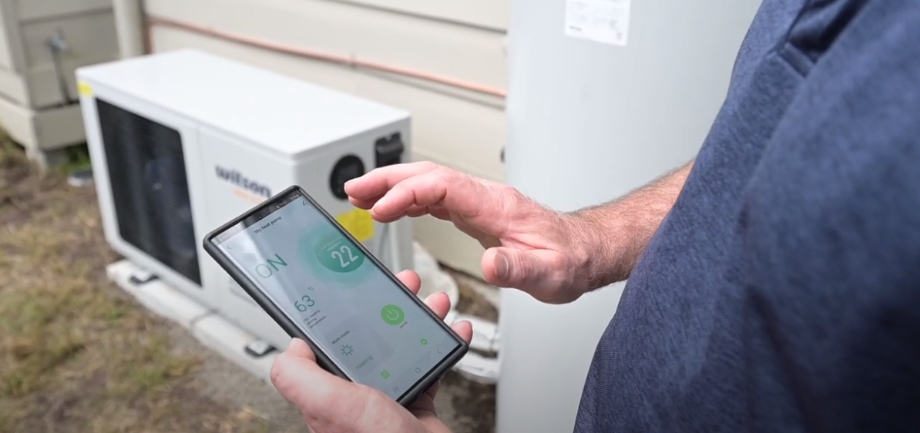
Smart Control Systems
Much like air conditioning systems, newer heat pumps are increasingly incorporating intelligent control systems designed to improve efficiency, as well as the overall user experience.
Digital Interfaces
User-friendly touch screens offer easy access to:
- Temperature settings
- Operating modes (Powerful, Smart, Silent)
- Timer functions
- System status information
Multiple Operating Modes
Premium systems like the Wilson Aqualux offer different operation profiles to suit various needs:
- Performance mode for maximum output
- Economy mode for optimal efficiency
- Silent mode for noise-sensitive times or locations
Smart Connectivity
Advanced models feature wireless connectivity that enables:
- Remote monitoring via smartphone apps
- System notifications and alerts
- Remote software updates for improved performance
- Integration with home automation systems
Heat Storage Functionality
Intelligent systems can store heat during optimal times (such as during daylight hours when solar panels are producing electricity), maximising energy efficiency and reducing operating costs.
Interested to learn more? Follow this link and discover the Wilson difference today!
Natural Refrigerant R290: The Future-Proof Solution
Environmental impact is becoming an increasingly important consideration for homeowners, which is why so many Australians are looking beyond the traditional options. One of the key factors influencing the capacity and efficiency of heat pump systems is the refrigerant used.
R290 (propane) refrigerant, a core component of the Wilson Aqualux series, is becoming more popular due to its exceptional environmental profile and excellent thermodynamic performance. Unlike many conventional refrigerants, an R290 refrigerant is:
-
Naturally occurring:
As a hydrocarbon, it exists naturally in the environment -
Non-toxic:
Safe for household applications with proper system design -
Ozone-friendly:
Zero ozone depletion potential (ODP) -
Climate-friendly:
Extremely low global warming potential (GWP) of just 3
To put it in perspective, this is how R290 compares to other common refrigerants:
| Refrigerant | Global Warming Potential (GWP) |
|---|---|
| R410A | 2088 |
| R134a | 1430 |
| R32 | 675 |
| R290 | 3 |
With regulatory changes increasingly limiting the use of high-GWP refrigerants, R290 represents a future-proof solution that delivers excellent performance while minimising environmental impact.
ECO FACT: R290 refrigerant has a global warming potential (GWP) of just 3—that’s nearly 700 times less impact than common refrigerants used in older systems!
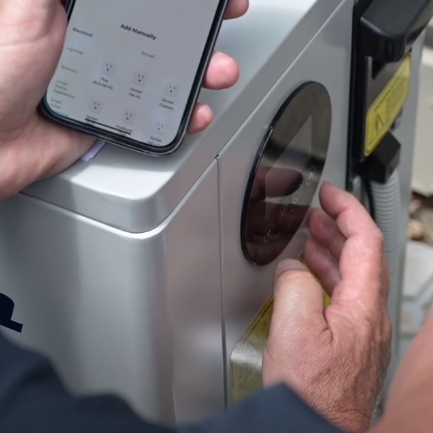
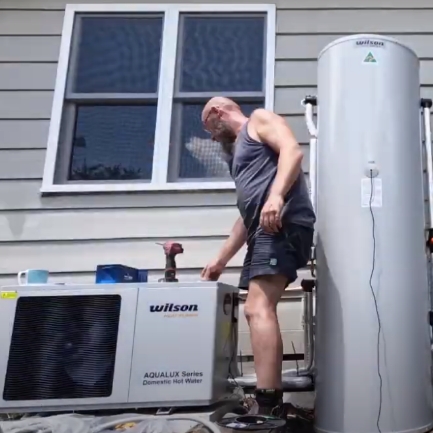
Engineered for Peace of Mind: Noise Reduction Technology
One of the most common concerns many people have about heat pump hot water systems is noise. The good news is that with advancements in design and manufacturing, newer models have incorporated sophisticated noise reduction features that make them quieter than ever before.
In the Aqualux series, Wilson has been able to achieve decibel levels as low as 39dB(A) at 1 meter—about the same as a quiet library. This is achieved through:
-
Floating Compressor Design:
Compressors are designed to "float" on the base of the unit, greatly reducing vibration transfer and associated noise. -
Double-Layer Soundproofing:
Compressors are surrounded by specialised sound-dampening materials that act as acoustic insulation to minimise operational noise. -
Streamlined Airflow Design:
Fan and ducting are engineered to maximise airflow efficiency while minimising air resistance and turbulence—major sources of noise in less sophisticated systems. -
Vibration-Resistant Construction:
The entire unit is meticulously designed to maximise performance while maintaining structural rigidity, preventing unnecessary vibrations that could generate noise.
How Much Does a Hot Water Heat Pump Cost? Average Costs and Pricing Considerations in Australia
Investing in a heat pump hot water system involves considering the initial cost, potential rebates, and long-term savings. Prices and incentives will vary across different areas of Australia, so always do some research into your specific situation.
High-Quality Heat Pumps in Australia vs. Cheap Alternatives: Why the Cheap Ones Don’t Work Well – Beware of Rebate Scams
While it may be tempting to go with the cheapest option on the market, this can be quite a costly mistake. This is because lower-priced heat pumps often use inferior components, leading to:
-
Reduced efficiency:
Lower COP, meaning higher running costs -
Shorter lifespan:
Premature failure, requiring replacement sooner -
Poor performance:
Inadequate hot water supply, especially in colder weather -
Higher noise levels:
Disruptive operation -
Limited warranty:
Less protection if something goes wrong -
Substitute electric elements:
Performance may not be up to par
Although the upfront cost may be initially higher, leading Australian manufacturers supply systems with far greater efficiency, reliability, and ongoing performance.
The cheapest heat pump may cost you more in the long run! Low-quality systems often have shorter lifespans and lower efficiency, leading to higher operational costs and earlier replacement.
Beware of “rebate scams” where installers inflate the price of a cheap system to claim a large rebate, leaving you with a substandard product. Always get multiple quotes and choose a reputable installer.
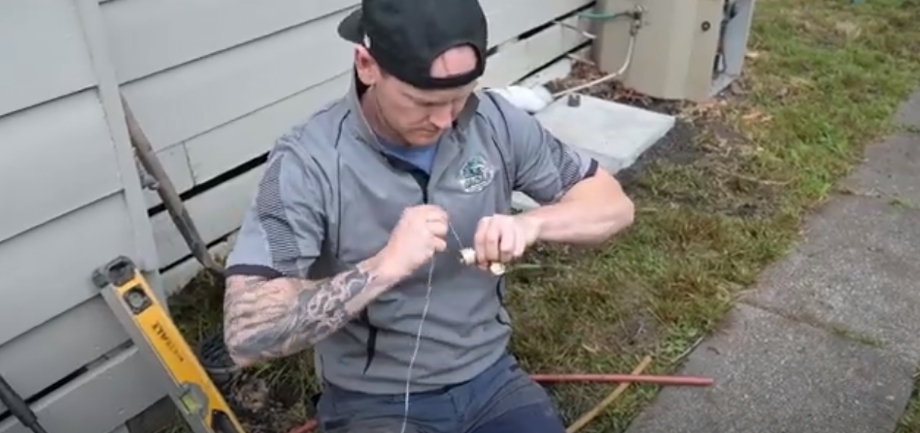
Rebate Rules in Different States
From climate change to cost-of-living, there are many reasons to make the switch. The good news is that there are government rebates on offer to ease the financial burden.
The rebates available do vary considerably between states. Here’s a brief overview:
-
New South Wales (NSW):
Offers rebates through Energy Savings Certificates (ESCs) under the Energy Savings Scheme. Eligibility can depend on factors like your existing hot water system and the new system's efficiency. -
Victoria (VIC):
Provides rebates through Victorian Energy Upgrades (VEU) program. Rebates can vary based on the system's efficiency and the postcode where it's installed. There may also be additional incentives for low-income households.
Wilson Heat Pumps qualify for Solar Victoria ‘Locally Made Products’ Rebate. Up to $1,400 rebate now available in Victoria for eligible customers. Click here to find out more https://www.solar.vic.gov.au/hot-water-rebate -
Queensland (QLD):
Offers rebates and interest-free loans through various programs. Eligibility criteria can include household income and the type of system being replaced. The Climate Smart Energy Savers program is a prime example. -
South Australia (SA):
The Retailer Energy Productivity Scheme (REPS) provides incentives. The value can depend on the system's efficiency and whether it replaces an electric or gas system. -
Western Australia (WA):
While there isn't a state-wide rebate scheme specifically for heat pumps, some local councils and energy retailers may offer their own incentives. It's always worth checking with your local council and electricity provider.
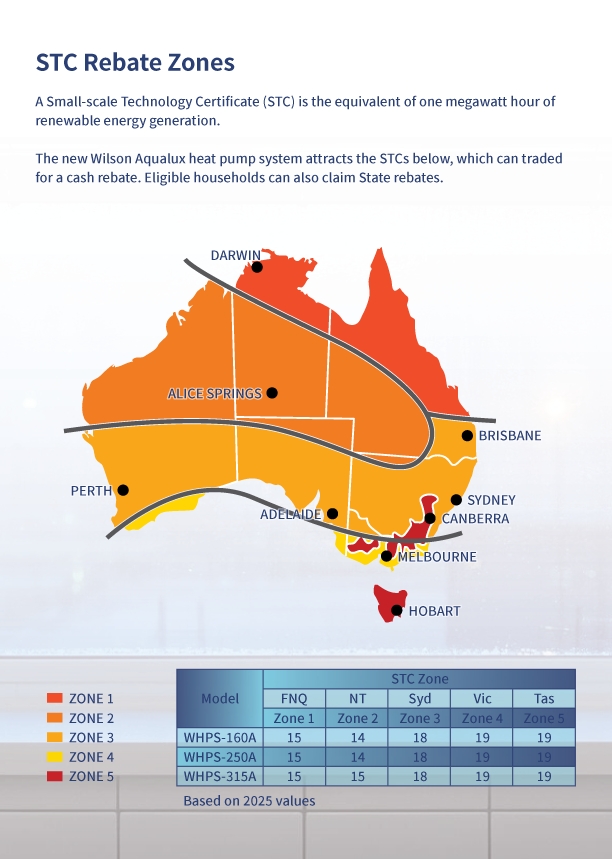
These are just general examples, and specific rules and rebate amounts change regularly. It’s important, therefore, to check the relevant government websites and consult with your installer for the most up-to-date information.
If you’re planning to buy a domestic Wilson heat pump system, be sure to use our free online tool to find rebates that apply to your local postcode.
Some rebates for heat pumps can cover up to 50% of the system cost! Always check current government incentives before purchasing—you might be surprised how affordable a premium system becomes after rebates.
How Much Does a Heat Pump Hot Water System Cost?
Several factors will influence the cost of a heat pump hot water system in Australia. These include:
-
System size:
Larger capacity units for bigger households cost more -
Brand and model:
Premium brands and models with advanced features naturally have higher prices -
Installation complexity:
Difficult installations (e.g., requiring significant plumbing modifications) add to the cost -
Rebates and incentives:
These can significantly reduce your out-of-pocket expense
Heat Pump System Cost Breakdown
A typical cost breakdown might look like this:
- Heat pump unit: $2,000 - $5,000
- Installation: $500 - $1,000
- Total cost (before rebates): $2,500 - $7,000
- Potential rebates: $500 - $2,000 (depending on location and system)
- Net cost (after rebates): $500- $5,500
Hot Water Solar System Price vs. Heat Pump Hot Water System Price
Traditional solar hot water systems (with roof-mounted panels) often have a higher upfront cost than heat pumps, typically ranging from $3,000 to $7,000 installed. While solar hot water can be very efficient in sunny conditions, heat pumps offer more consistent performance regardless of weather and can be a more cost-effective option in many cases.
Disclaimer: The prices listed are general estimates and can vary based on factors such as system size, brand, installation complexity, and location. Additional costs may apply for plumbing modifications, electrical work, or permit requirements. For an accurate quote, consult with a licensed dealer in your local area.
Return on Investment and Long-Term Savings
While the initial investment in a heat pump hot water system is higher than a conventional electric storage system, the significantly lower running costs lead to a relatively quick payback period, typically within 3-5 years. After this, you’ll continue to enjoy substantial savings on your energy bills for the life of the system (10-15+ years).
Systems with higher efficiency ratings, like Wilson’s Aqualux with its COP of 4.52, can offer even faster payback periods due to their superior energy performance.
Installation and Maintenance
As with any appliance, proper installation and regular maintenance are the best way to get the most out of your heat pump hot water system.
Heat Pump Installation: What to Expect
The installation process typically involves:
- Site assessment: The installer will evaluate your existing hot water system, available space, and electrical connections.
- System selection: Choosing the right size and type of heat pump for your household's needs.
- Removal of old system: Disconnecting and removing your existing water heater (if applicable).
- Installation of new system: Positioning the heat pump, connecting plumbing and electrical wiring.
- Testing and commissioning: Ensuring the system is operating correctly and efficiently.
- Explanation of operation: The installer should provide you with instructions on how to use and maintain the system.
Finding a Reliable Heat Pump Installer
Choosing a qualified and experienced installer is essential. Look for:
-
Licensing and certification:
Ensure the installer holds the necessary licenses and certifications for plumbing and electrical work in your state. -
Experience:
Ask about their experience with heat pump installations, specifically. -
References:
Request references from previous customers. -
Quotes:
Obtain multiple quotes to compare pricing and services. -
Warranty:
Understand the installer's warranty on their workmanship.
Routine Maintenance for Longevity
Regular maintenance will help keep your heat pump hot water system running efficiently and extend its lifespan. Typical maintenance tasks include:
-
Annual servicing:
Have a qualified technician inspect and service the system annually. -
Cleaning:
Keep the area around the unit clear of debris and vegetation. -
Checking for leaks:
Regularly inspect for any signs of water leaks. -
Checking pressure relief valve:
Ensure the pressure relief valve is functioning correctly. -
Checking anode (if applicable):
For systems with storage tanks that use sacrificial anodes.
Sizing and Performance
Choosing the right size heat pump hot water system is crucial for ensuring adequate hot water supply and maximising energy efficiency.
What Size Heat Pump Hot Water System Do I Need?
The appropriate size depends on several factors:
- Household size: The number of people in your home.
- Hot water usage: Your typical daily hot water consumption.
- Climate: Colder climates may require a larger or more powerful system.
- Usage patterns: Do you have high peak demands (e.g., multiple showers at the same time)?
A general guide is:
- 1-2 people: 160-200 litre system
- 3-4 people: 250-315 litre system
- 5+ people: 315-400 litre system
Premium manufacturers like Wilson offer tanks in these exact size ranges (160L, 250L, 315L) to match different household needs. Still finding yourself asking the question of “what size heat pump hot water system do I need?”, well, it’s always best to consult with a qualified installer to find a model that best suits your space, capacity, and household size.
Comparing Hot Water Pumps
As you assess the different models, consider these key performance indicators:
- COP (Coefficient of Performance): Higher is better. Premium models like Wilson Aqualux achieve 4.52 under standard conditions.
- Noise levels: Measured in decibels (dB). Lower is better. The best models operate at around 39dB.
- Operating temperature range: Wider is better. Leading systems can operate from -25°C to 45°C.
- Maximum water temperature: Higher temperatures provide more usable hot water. Top systems can deliver water at 60-63°C.
- Tank warranty: Longer is better. Premium systems offer 10-year tank warranties.
- Heat pump warranty: Longer is better. Quality systems typically offer 6-year warranties.
- Does the unit have an electric element: This is another important factor to consider
Heating Water Pump Efficiency and Savings
As household bills become higher than ever, everyone can benefit from upgrading to more energy efficient hot water systems.
The efficiency of a heat pump is measured by its Coefficient of Performance (COP). A higher COP means greater efficiency. Heat pumps typically have COPs ranging from 3.0 to 5.0, meaning they produce 3 to 5 units of heat for every unit of electricity consumed. This translates to significant energy savings compared to conventional electric water heaters.
When selecting a system, look for those with higher COP ratings under a range of operating conditions, not just optimal conditions. The most efficient systems, like those in the Wilson Aqualux series, maintain good efficiency even in challenging weather conditions.
When to Consider a Larger or Smaller Unit
- Larger unit: If you have high hot water demands, frequent guests, or plan to expand your household, consider a larger unit. Premium manufacturers offer sizes up to 315L for larger households.
- Smaller unit: If you have low hot water usage and a small household, a smaller unit (such as 160L) may be sufficient and more cost-effective.
Performance, Durability, and Troubleshooting
Let’s now transition into a breakdown of the many functional aspects of a heat pump hot water system.
How Long Do Heat Pump Hot Water Systems Last?
A well-maintained heat pump hot water system typically lasts for 10-15 years, or even longer in certain circumstances. The lifespan can be influenced by factors such as:
- Water quality: Hard water can affect system components
- Usage patterns: Heavier usage may lead to faster wear
- Maintenance practices: Regular servicing extends lifespan
- Component quality: Premium components (like those in Wilson systems) typically last longer
- Environmental conditions: Extreme conditions may impact longevity
Leading manufacturers back their confidence in their products with comprehensive warranties. For example, Wilson heat pump systems come with a 6-year warranty on the heat pump components and up to 10 years on the tank.
A longer warranty period often indicates the manufacturer's confidence in their product. Look for heat pumps with extended warranties on both the tank and heat pump components for maximum peace of mind.
Do Heat Pump Hot Water Systems Work in Cold Weather?
If you live in a location with a cooler climate, such as Victoria, ACT, or Tasmania, a common question you might have is “do heat pump hot water systems work in cold weather?” The answer? Yes, of course.
New heat pumps are designed to operate efficiently in a wide range of temperatures. Many quality models will also function effectively even when operated in sub-zero conditions. For example, the Wilson Aqualux series is engineered to operate in temperatures as low as -25°C, making it suitable for even the coldest Australian winter conditions.
Don't let myths about heat pumps fool you! Premium models work efficiently even in sub-zero temperatures. Look for systems rated to at least -10°C for year-round performance in most Australian locations.
However, it’s still worth noting that efficiency may decrease in extremely cold weather. Luckily, some models come with a booster element that helps to deliver an adequate hot water supply in these more extreme circumstances. Since these conditions are rarely seen in Australia, this isn’t too much of a concern.
Can a Heat Pump Hot Water System Be Installed Indoors?
The vast majority of heat pump hot water systems are designed for outdoor installation. This is because they require adequate ventilation to draw in and expel air. However, some models, particularly split systems like the Wilson Aqualux, can have the tank installed indoors while the heat pump unit remains outside, which ultimately allows for greater installation flexibility.
Dealing with Noise, Space, and Climate Challenges
- Noise: Modern heat pumps are generally much quieter than older models. Premium systems like the Wilson Aqualux operate at just 39dB (measured at 1 meter), about the same as a library whisper.
NOISE: 39dB is quieter than a normal conversation (60dB) and even the average household fridge (40dB). Noise-optimised heat pumps will operate day and night without any disturbance to your household or neighbours.
- Space: Heat pumps require adequate space for installation and airflow. Make sure that you have sufficient clearance around the unit as specified by the manufacturer.
Climate: Choose a system designed for your specific climate zone. In Australia, look for systems with wide operating temperature ranges like -25°C to 45°C for the best year-round performance.
Electric Heat Pump Hot Water System vs. Gas Alternatives
Heat pumps offer several advantages over gas hot water systems. Most notably these include:
- Higher efficiency: Heat pumps are generally more energy-efficient than gas systems.
- Lower greenhouse gas emissions: Heat pumps produce fewer emissions, especially when powered by renewable energy.
- Safety: Heat pumps do not involve combustion, eliminating the risk of gas leaks or carbon monoxide poisoning.
- Renewable Energy: Can connect to Solar PV.
- Rebates: The chance to reduce installation costs with government rebates.
What Is the Best Heat Pump in Australia?
Once you’ve decided to go with a heat pump hot water system, the next step is to compare the different options available. Here’s how some of the top contenders in the Australian market compare:
Top Heat Pump Brands Comparison:
| Brand | Strengths | Best For |
|---|---|---|
| Wilson (Aqualux Series) | Australian-made tank with 95+ years of hot water experience, uses R290 refrigerant (GWP of only 3), excellent COP of 4.52, extremely quiet operation (39dB), wide operating temperature range (-25°C to 45°C) | Anyone wanting Australian-made quality, noise-sensitive installations, extreme climate conditions |
| Sanden | CO2 refrigerant (R744), cold weather performance, split system design | Environmentally conscious buyers, cold climates |
| Rheem | Reliable performance, warranty coverage, service network | Budget-conscious buyers seeking reliability, simpler installations |
| Stiebel Eltron | German engineering, controls, build quality | Buyers seeking longevity |
| Bosch | European design, cold weather performance | Noise-sensitive installations, colder regions |
The right choice boils down to your specific circumstances, be it the household size, climate, budget, and general hot water demands. However, we do recommend considering everything from long-term value to energy efficiency, technological features, durability, sustainability, and warranty coverage.
Please note, the prices shown above are only estimates. Always check with your installer and get a detailed quote for installation.
Warranty and After-Sales Support
As you explore the various heat pump hot water system options, always keep an eye out for warranty coverage and after-sales support. For example, you can consider all of the following aspects:
- Component Coverage: Look for differentiated coverage that provides longer protection for the most expensive components.
- Tank Warranty: Since the tank represents a significant portion of the system cost, longer tank warranties provide valuable long-term protection. Wilson offers a 10-year tank warranty (excluding WA).
- Manufacturer Heritage: Companies with long-standing presence in the Australian market (like Wilson with 90+ years) are more likely to honor warranty commitments and provide spare parts throughout the system’s lifetime.
- Service Network: Nationwide service availability ensures that warranty claims and maintenance needs can be addressed promptly, minimising downtime.
While evaluating the product’s warranty, be sure to read the fine print regarding installation requirements, as improper installation may void warranty coverage.
Sustainability and Peace of Mind
Sustainability is, without a doubt, one of the key reasons so many Australians are making the switch to more energy efficient hot water systems. As we all experience the effects of climate change, the ability to invest in more eco-friendly household appliances has become more important than ever.
Extreme Climate Compatibility
Wilson Aqualux tanks have been tested in line with AS 2515 standards and are proven to operate safely in Australia’s harshest conditions:
- Wide temperature range: Operation from -25°C to 45°C ensures reliable performance year-round in all Australian climates.
- Weather-resistant construction: Robust outdoor units withstand sun, rain, and varying weather conditions.
- Anti-freezing protection: Built-in safeguards prevent damage in freezing conditions.
Multiple Operating Modes
The more advanced the system, the more user-friendly it is likely to be. This includes different operating functions to suit various needs, including:
- Low noise modes for quiet operation near living spaces
- Performance modes for maximum efficiency and output
- Automatic modes for optimal balance of performance and energy use
Warranty Coverage
Comprehensive warranty packages provide peace of mind:
- Heat pump units: Typically 5-6 years warranty coverage
- Storage tanks: Up to 10 years warranty on premium models
- Manufacturer support: Established companies with longstanding Australian presence provide reliable after-sales support
By choosing systems with these sustainability and reliability features, you’ll not only enjoy substantial energy savings but also the assurance of dependable hot water for many years to come.
The Ultimate Guide to Heat Pump Hot Water Systems: Final Thoughts
Summary of Key Benefits
Heat pump hot water systems offer a compelling range of advantages for Australian households. Most notably, these include:
- Energy Efficiency: They can use significantly less electricity than conventional electric systems, reducing your energy bills.
- Environmental Impact: These systems have a lower carbon footprint, particularly when combined with renewable energy sources like solar panels.
- Long-Term Savings: While the initial investment might be higher, the long-term savings often result in a relatively short payback period, followed by continued cost reductions.
- Reliability: High-quality systems are designed to provide many years of dependable service, offering a worthwhile long-term investment.
- Performance: They deliver consistent hot water in most Australian climate conditions.
- Government Support: Rebates and incentives are often available in many states, making the initial investment more affordable.
At Wilson, we’re proud to produce the best hot water heat pumps on the market today. Our Aqualux series comes with excellent efficiency, proven cold-weather performance (operating down to -25°C), reduced noise levels (as low as 39dB), and smart features for the ultimate level of convenience.
The Aqualux R290 (our signature model) also features innovative Mitsubishi inverter compressors, variable-speed fans, low noise levels, and an environmentally friendly R290 refrigerant.
Take the Next Step with Wilson
Ready to turn your search into a reality with a Wilson heat pump hot water system? Here’s a straightforward plan to guide you:
Your Heat Pump Hot Water System Action Plan:
- Assess Your Needs:
- Determine the number of people in your household and estimate your typical hot water usage.
- Identify peak usage times (e.g., morning showers, evening baths).
- Consider any special requirements, such as large bathtubs or multiple bathrooms.
- Research Rebates and Incentives:
- Check your state government’s websites for energy efficiency programs.
- Contact your energy provider to inquire about any additional incentives they may offer.
- Familiarise yourself with eligibility criteria and the application procedures
- Calculate government rebates in your local area with Wilson.
- Get Quotes from Reputable Installers:
- Contact several qualified installers for quotes and advice.
- Ask about their experience with heat pump installations.
- Inquire about available rebates and promotions.
- Discuss various installation options and requirements.
- Prepare for Installation:
- Ensure clear access to the installation area.
- Consider the optimal location for the unit to maximise efficiency and minimise noise.
- If possible, schedule the installation during off-peak hours.
- Establish a Maintenance Routine:
- Schedule regular professional servicing, ideally annually.
- Familiarise yourself with basic maintenance tasks you can perform as the owner.
- Keep the manufacturer’s documentation handy for reference.
FAQs and Additional Tips
How Do Heat Pump Hot Water Systems Work?
Heat pumps work by extracting heat from the surrounding air and transferring it to the water in the storage tank. They use a refrigeration cycle similar to that of a refrigerator, but in reverse. This process is highly efficient because it moves heat rather than generating it directly.
How Much Energy Does a Hot Water Heat Pump Save?
Heat pumps can save up to 78% of energy compared to conventional electric water heaters. The exact savings depend on factors such as the system’s efficiency, your hot water usage, and your climate. Premium models with high COP ratings (like the Wilson Aqualux with 4.52 COP) deliver the greatest savings.
Are Heat Pump Hot Water Systems Worth It in the Long Run?
Absolutely! Heat pumps are both durable and suitable for most households. Of course, you’ll always want to invest in a brand that offers long-term warranty coverage, as well as a demonstrated track record for manufacturing high-quality products.
Could a Heat Pump Replace My Existing System?
In most cases, a heat pump can replace an existing electric or gas hot water system. However, a qualified installer should assess your specific situation to ensure a smooth transition. Split systems like the Wilson Aqualux offer greater installation flexibility, with separate heat pump and tank components that can be positioned for optimal performance and convenience.

